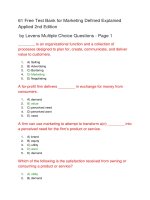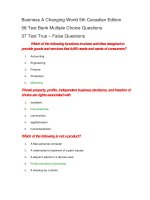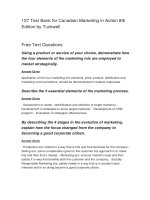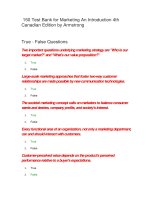Test bank business statistics communicating with numbers 2nd edition by jaggia kelly
Bạn đang xem bản rút gọn của tài liệu. Xem và tải ngay bản đầy đủ của tài liệu tại đây (733.15 KB, 128 trang )
Test Bank Business Statistics: Communicating with Numbers 2nd Edition by
Jaggia Kelly
Completed instant download:
Chapter 03 Test Bank Key
1.
The terms central location or central tendency refer to the way quantitative data tend to cluster
around some middle or central value.
TRUE
The term <i>central location</i> relates to the way quantitative data tend to cluster around
some middle or central value.
AACSB: Analytical Thinking
Accessibility: Keyboard Navigation
Blooms: Remember
Difficulty: 1 Easy
Jaggia - Chapter 03 #1
Learning Objective: 03-01 Calculate and interpret the mean, the median, and the mode.
Topic: Measures of Central Location
2.
The arithmetic mean is the middle value of a data set.
FALSE
The median is the middle value of a data set.
AACSB: Analytical Thinking
Accessibility: Keyboard Navigation
Blooms: Remember
Difficulty: 1 Easy
Jaggia - Chapter 03 #2
Learning Objective: 03-01 Calculate and interpret the mean, the median, and the mode.
Topic: Measures of Central Location
3.
Approximately 60% of the observations in a data set fall below the 60th percentile.
TRUE
Percentile is defined as the approximate percentage of the observations have values below
the percentile value.
AACSB: Analytical Thinking
Accessibility: Keyboard Navigation
Blooms: Remember
Difficulty: 1 Easy
Jaggia - Chapter 03 #3
Learning Objective: 03-02 Calculate and interpret percentiles and a box plot.
Topic: Percentiles and Box Plots
4.
The median is not always the 50th percentile.
FALSE
The median is always the 50th percentile. If n is odd, L50 = (n + 1)/2 is an integer directly
defining the unique middle position in the sorted data set. If n is even, L50 = (n + 1)/2 is the
average of the two middle positions n/2 and n/2 + 1, and hence the median is the average of
the corresponding two middle values.
AACSB: Analytical Thinking
Blooms: Understand
Difficulty: 2 Medium
Jaggia - Chapter 03 #4
Learning Objective: 03-01 Calculate and interpret the mean, the median, and the mode.
Learning Objective: 03-02 Calculate and interpret percentiles and a box plot.
Topic: Percentiles and Box Plots
5.
In a data set, an outlier is a large or small value regarded as an extreme value in the data set.
TRUE
Outliers are extremely small or large values in the data set.
AACSB: Analytical Thinking
Accessibility: Keyboard Navigation
Blooms: Remember
Difficulty: 1 Easy
Jaggia - Chapter 03 #5
Learning Objective: 03-02 Calculate and interpret percentiles and a box plot.
Topic: Percentiles and Box Plots
6.
A box plot is useful when comparing similar information gathered at different places or times.
TRUE
A boxplot or box-and-whisker plot is a convenient way to graphically display the smallest
value, the quartiles, and the largest value.
AACSB: Analytical Thinking
Accessibility: Keyboard Navigation
Blooms: Understand
Difficulty: 2 Medium
Jaggia - Chapter 03 #6
Learning Objective: 03-02 Calculate and interpret percentiles and a box plot.
Topic: Percentiles and Box Plots
7.
The geometric mean is a multiplicative average of a data set.
TRUE
The geometric mean is a multiplicative average, as opposed to an additive average.
AACSB: Analytical Thinking
Accessibility: Keyboard Navigation
Blooms: Remember
Difficulty: 1 Easy
Jaggia - Chapter 03 #7
Learning Objective: 03-03 Calculate and interpret a geometric mean return and an average growth rate.
Topic: The Geometric Mean
8.
The mean absolute deviation (MAD) is a less effective measure of variation when compared
with the average deviation from the mean.
FALSE
The MAD is a much more effective measure. The average deviation from the mean is actually
useless because it is always zero.
AACSB: Analytical Thinking
Accessibility: Keyboard Navigation
Blooms: Understand
Difficulty: 2 Medium
Jaggia - Chapter 03 #8
Learning Objective: 03-04 Calculate and interpret the range, the mean absolute deviation, the variance, the standard deviation, and the coefficient of
variation.
Topic: Measures of Dispersion
9.
The variance and standard deviation are the most widely used measures of central location.
FALSE
The variance and standard deviation are the most widely used measures of dispersion.
AACSB: Analytical Thinking
Accessibility: Keyboard Navigation
Blooms: Understand
Difficulty: 1 Easy
Jaggia - Chapter 03 #9
Learning Objective: 03-04 Calculate and interpret the range, the mean absolute deviation, the variance, the standard deviation, and the coefficient of
variation.
Topic: Measures of Dispersion
10.
The standard deviation is the positive square root of the variance.
TRUE
The standard deviation is the positive square root of the variance:
AACSB: Analytical Thinking
Blooms: Remember
Difficulty: 1 Easy
Jaggia - Chapter 03 #10
Learning Objective: 03-04 Calculate and interpret the range, the mean absolute deviation, the variance, the standard deviation, and the coefficient of
variation.
Topic: Measures of Dispersion
11.
The variance is an average squared deviation from the mean.
TRUE
The variance is computed as
AACSB: Analytical Thinking
Blooms: Understand
Difficulty: 2 Medium
Jaggia - Chapter 03 #11
Learning Objective: 03-04 Calculate and interpret the range, the mean absolute deviation, the variance, the standard deviation, and the coefficient of
variation.
Topic: Measures of Dispersion
12.
The coefficient of variation is a unit-free measure of dispersion.
TRUE
The coefficient of variation is computed as
and is a relative measure of dispersion.
AACSB: Analytical Thinking
Blooms: Remember
Difficulty: 1 Easy
Jaggia - Chapter 03 #12
Learning Objective: 03-04 Calculate and interpret the range, the mean absolute deviation, the variance, the standard deviation, and the coefficient of
variation.
Topic: Measures of Dispersion
13.
Mean-variance analysis suggests that investments with lower average returns are also
associated with higher risks.
FALSE
Mean-variance analysis suggests that investments with lower average returns are also
associated with lower risks.
AACSB: Analytical Thinking
Accessibility: Keyboard Navigation
Blooms: Understand
Difficulty: 2 Medium
Jaggia - Chapter 03 #13
Learning Objective: 03-05 Explain mean-variance analysis and the Sharpe ratio.
Topic: Mean-Variance Analysis and the Sharpe Ratio
14.
The Sharpe ratio measures the extra reward per unit of risk.
TRUE
The Sharpe ratio for an investment is computed as
AACSB: Analytical Thinking
Blooms: Remember
Difficulty: 1 Easy
Jaggia - Chapter 03 #14
Learning Objective: 03-05 Explain mean-variance analysis and the Sharpe ratio.
Topic: Mean-Variance Analysis and the Sharpe Ratio
15.
Chebyshev’s theorem is only applicable for sample data.
FALSE
Chebyshev’s theorem is valid for both sample and population data.
AACSB: Analytical Thinking
Accessibility: Keyboard Navigation
Blooms: Understand
Difficulty: 2 Medium
Jaggia - Chapter 03 #15
Learning Objective: 03-06 Apply Chebyshevs theorem, the empirical rule, and z-scores.
Topic: Analysis of Relative Location
16.
The empirical rule is only applicable for approximately bell-shaped data.
TRUE
The empirical rule can be applied to the distribution that is relatively symmetric and bellshaped.
AACSB: Analytical Thinking
Accessibility: Keyboard Navigation
Blooms: Remember
Difficulty: 1 Easy
Jaggia - Chapter 03 #16
Learning Objective: 03-06 Apply Chebyshevs theorem, the empirical rule, and z-scores.
Topic: Analysis of Relative Location
17.
Z-scores can always be used to detect outliers.
FALSE
<i>Z</i>-scores can only be used to detect outliers when the data are relatively symmetric and
bell-shaped.
AACSB: Analytical Thinking
Accessibility: Keyboard Navigation
Blooms: Understand
Difficulty: 2 Medium
Jaggia - Chapter 03 #17
Learning Objective: 03-06 Apply Chebyshevs theorem, the empirical rule, and z-scores.
Topic: Analysis of Relative Location
18.
The formula for a z-score is
FALSE
The formula for a z-score is
AACSB: Analytical Thinking
Blooms: Remember
Difficulty: 1 Easy
Jaggia - Chapter 03 #18
Learning Objective: 03-06 Apply Chebyshevs theorem, the empirical rule, and z-scores.
Topic: Analysis of Relative Location
19.
Outliers are extreme values above or below the mean that require special consideration.
TRUE
Outliers are extremely small or large values.
AACSB: Analytical Thinking
Accessibility: Keyboard Navigation
Blooms: Understand
Difficulty: 2 Medium
Jaggia - Chapter 03 #19
Learning Objective: 03-01 Calculate and interpret the mean, the median, and the mode.
Topic: Measures of Central Location
20.
Mark’s grade on the recent business statistics test was an 85 on a scale of 0-100. Based
onthis information we canconclude that Mark’s grade was in the 85th percentile in his class.
FALSE
The pth percentile divides the class into two parts, where approximately p percent of the values
are less than pth percentile and the rest of the grades are greater than the pth percentile.
AACSB: Analytical Thinking
Blooms: Understand
Difficulty: 2 Medium
Jaggia - Chapter 03 #20
Learning Objective: 03-02 Calculate and interpret percentiles and a box plot.
Topic: Percentiles and Box Plots
21.
Geometric mean is greater than the arithmetic mean.
FALSE
Geometric mean is smaller than the arithmetic mean and is less sensitive to outliers.
AACSB: Analytical Thinking
Accessibility: Keyboard Navigation
Blooms: Understand
Difficulty: 2 Medium
Jaggia - Chapter 03 #21
Learning Objective: 03-03 Calculate and interpret a geometric mean return and an average growth rate.
Topic: The Geometric Mean
22.
In quality control settings, businesses prefer a larger standard deviation, which is an indication
of more consistency in the process.
FALSE
The larger the standard deviation is, the more variable the data are. Businesses prefer a
smaller standard deviation.
AACSB: Analytical Thinking
Accessibility: Keyboard Navigation
Blooms: Understand
Difficulty: 2 Medium
Jaggia - Chapter 03 #22
Learning Objective: 03-04 Calculate and interpret the range, the mean absolute deviation, the variance, the standard deviation, and the coefficient of
variation.
Topic: Measures of Dispersion
23.
The z-score has no units even though the original values will normally be expressed in units
such as dollars, years,pounds, or calories.
FALSE
A <i>z</i>-score is a unitless measure because its numerator and the denominator have the
same units.
AACSB: Analytical Thinking
Accessibility: Keyboard Navigation
Blooms: Understand
Difficulty: 2 Medium
Jaggia - Chapter 03 #23
Learning Objective: 03-06 Apply Chebyshevs theorem, the empirical rule, and z-scores.
Topic: Analysis of Relative Location
24.
When working with grouped data, the class median is the value in the middle of the class and
can be found by taking the average of the endpoints for each class.
FALSE
The midpoint is the value in the middle of the class and is calculated by averaging the
endpoints of the class.
AACSB: Analytical Thinking
Accessibility: Keyboard Navigation
Blooms: Understand
Difficulty: 2 Medium
Jaggia - Chapter 03 #24
Learning Objective: 03-07 Calculate the mean and the variance for grouped data.
Topic: Summarizing Grouped Data
25.
The median is defined asthe______________.
A. middle point in a data set.
B. geometric average of a data set.
C. arithmetic average of a data set.
D. most common value of a data set.
AACSB: Analytical Thinking
Blooms: Remember
Difficulty: 1 Easy
Jaggia - Chapter 03 #25
Learning Objective: 03-01 Calculate and interpret the mean, the median, and the mode.
Topic: Measures of Central Location
26.
The mode is defined as the _____________.
A. middle point in a data set.
B. geometric average of a data set.
C. arithmetic average of a data set.
D. most frequent value in a data set.
AACSB: Analytical Thinking
Accessibility: Keyboard Navigation
Blooms: Remember
Difficulty: 1 Easy
Jaggia - Chapter 03 #26
Learning Objective: 03-01 Calculate and interpret the mean, the median, and the mode.
Topic: Measures of Central Location
27.
Which of the following is the most influenced by outliers?
A. Mode
B. Median
C.
75th percentile
D. Arithmetic mean
AACSB: Analytical Thinking
Blooms: Understand
Difficulty: 2 Medium
Jaggia - Chapter 03 #27
Learning Objective: 03-01 Calculate and interpret the mean, the median, and the mode.
Topic: Measures of Central Location
28.
How do we find the median if the number of observations in a data set is odd?
A. By averaging the first and the third quartile
B. By taking the middle value in the sorted data set
C. By averaging the minimum and maximum values
D. By taking the middle value in the sorted data set after eliminating outliers
AACSB: Analytical Thinking
Accessibility: Keyboard Navigation
Blooms: Remember
Difficulty: 1 Easy
Jaggia - Chapter 03 #28
Learning Objective: 03-01 Calculate and interpret the mean, the median, and the mode.
Topic: Measures of Central Location
29.
Is it possible for a data set to have no mode?
A. Yes, if two observations occur twice.
B. No, unless there is an odd number of observations.
C. No, if the data set is nonempty, there is always a mode.
D. Yes, if there are no observations that occur more than once.
AACSB: Analytical Thinking
Accessibility: Keyboard Navigation
Blooms: Understand
Difficulty: 2 Medium
Jaggia - Chapter 03 #29
Learning Objective: 03-01 Calculate and interpret the mean, the median, and the mode.
Topic: Measures of Central Location
30.
Is it possible for a data set to have more than one mode?
A. No, there must always be a single mode, or else there is no mode.
B. Yes, if two or more values in a data set occur the same number of times.
C. Yes, if there are at least two different values in a data set, there is always more than one
mode.
D. Yes, if two or more values in a data set occur with the most frequency and the frequency is
greater than one.
AACSB: Analytical Thinking
Accessibility: Keyboard Navigation
Blooms: Understand
Difficulty: 2 Medium
Jaggia - Chapter 03 #30
Learning Objective: 03-01 Calculate and interpret the mean, the median, and the mode.
Topic: Measures of Central Location
31.
The Boom company has recently decided to raise the salaries of all employees by 10%.Which
of the following is(are) expected to be affected by this raise?
A. Mean and mode only
B. Mean and median only
C. Mode and median only
D. Mean, median, and mode
AACSB: Analytical Thinking
Accessibility: Keyboard Navigation
Blooms: Understand
Difficulty: 2 Medium
Jaggia - Chapter 03 #31
Learning Objective: 03-01 Calculate and interpret the mean, the median, and the mode.
Topic: Measures of Central Location
32.
The owner of a company has recently decided to raise the salary of one employee, who was
already making the highest salary, by 20%. Which of the following is(are) expected to be
affected by this raise?
A. Mean only
B. Median only
C. Mean and median only
D. Mean, median, and mode
AACSB: Analytical Thinking
Accessibility: Keyboard Navigation
Blooms: Apply
Difficulty: 2 Medium
Jaggia - Chapter 03 #32
Learning Objective: 03-01 Calculate and interpret the mean, the median, and the mode.
Topic: Measures of Central Location
33.
The table below gives the deviations of a portfolio’s annual total returns from its benchmark’s
annual returns, for a 6-year period ending in 2011.
Portfolio’s deviations from Benchmark Return,
2006-2011
2006
–7.62%
2007
2.37%
2008
–9.11%
2009
0.55%
2010
5.48%
2011
–1.67%
The arithmetic mean return and median return are the closest to _______.
A.
mean = –2.00% and median = –4.28%.
B.
mean = –2.00% and median = –1.67%.
C.
mean = –1.67% and median = –0.56%.
D.
mean = –1.67% and median = 0.56%
AACSB: Analytical Thinking
Blooms: Understand
Difficulty: 2 Medium
Jaggia - Chapter 03 #33
Learning Objective: 03-01 Calculate and interpret the mean, the median, and the mode.
Topic: Measures of Central Location
34.
Which of the following statements is most accurate when defining percentiles?
A.
B.
C.
D.
The pth percentile divides a data set into equal parts.
Approximately p% of the observations are greater than the pth percentile.
Approximately (100 – p)% of the observations are less than the pth percentile.
Approximately (100 – p)% of the observations are greater than the pth percentile.
AACSB: Analytical Thinking
Blooms: Understand
Difficulty: 2 Medium
Jaggia - Chapter 03 #34
Learning Objective: 03-02 Calculate and interpret percentiles and a box plot.
Topic: Percentiles and Box Plots
35.
Which five values are graphed on a box plot?
A. Min, Quintile 1, Mean, Quintile 3, Max
B. Min, Quartile 1, Mean, Quartile 3, Max
C. Min, Quintile 1, Median, Quintile 3, Max
D. Min, Quartile 1, Median, Quartile 3, Max
AACSB: Analytical Thinking
Accessibility: Keyboard Navigation
Blooms: Understand
Difficulty: 2 Medium
Jaggia - Chapter 03 #35
Learning Objective: 03-02 Calculate and interpret percentiles and a box plot.
Topic: Percentiles and Box Plots
36.
What is the interquartile range?
A.
Q3 – Q1
B.
Max – Min
C.
Mean – Median
D. All values between Q1 and Q3
AACSB: Analytical Thinking
Blooms: Remember
Difficulty: 1 Easy
Jaggia - Chapter 03 #36
Learning Objective: 03-02 Calculate and interpret percentiles and a box plot.
Topic: Percentiles and Box Plots
37.
Consider the following data: 1, 2, 4, 5, 10, 12, 18. The 30th percentile is the closest to ____.
A. 2.0
B. 2.4
C. 2.8
D. 5.0
AACSB: Analytical Thinking
Blooms: Understand
Difficulty: 2 Medium
Jaggia - Chapter 03 #37
Learning Objective: 03-02 Calculate and interpret percentiles and a box plot.
Topic: Percentiles and Box Plots
38.
Calculate the interquartile range from the following data: 1, 2, 4, 5, 10, 12, 18.
A. 5
B. 6
C. 10
D. 17
AACSB: Analytical Thinking
Blooms: Understand
Difficulty: 2 Medium
Jaggia - Chapter 03 #38
Learning Objective: 03-02 Calculate and interpret percentiles and a box plot.
Topic: Percentiles and Box Plots
39.
As of September 30, 2011, the earnings per share, EPS, of five firms in the beverages
industry are as follows: 1.13 2.41 1.52 1.40 0.41 The 25th percentile and the 75th percentile of
the EPS are the closest to __________.
A. 0.77 and 1.97
B. 0.91 and 1.77
C. 1.77 and 0.91
D. 1.97 and 0.77
AACSB: Analytical Thinking
Blooms: Understand
Difficulty: 2 Medium
Jaggia - Chapter 03 #39
Learning Objective: 03-02 Calculate and interpret percentiles and a box plot.
Topic: Percentiles and Box Plots
40.
In what way(s) is(are) the concept of geometric mean useful?
A. In evaluating investment returns
B. In calculating average growth rates
C. In assessing the dispersion of the data
D. Both in evaluating investment returns and in calculating average growth rates
AACSB: Analytical Thinking
Accessibility: Keyboard Navigation
Blooms: Understand
Difficulty: 2 Medium
Jaggia - Chapter 03 #40
Learning Objective: 03-03 Calculate and interpret a geometric mean return and an average growth rate.
Topic: The Geometric Mean
41.
What is(are) characteristic(s) of the geometric mean?
A. It is always greater than the arithmetic mean.
B. It is the mathematical equivalent to the median.
C. It is always less than or equal to the arithmetic mean.
D. Both it is the mathematical equivalent to the median and it is always less than or equal to
the arithmetic mean.
AACSB: Analytical Thinking
Accessibility: Keyboard Navigation
Blooms: Understand
Difficulty: 2 Medium
Jaggia - Chapter 03 #41
Learning Objective: 03-03 Calculate and interpret a geometric mean return and an average growth rate.
Topic: The Geometric Mean
42.
Sales for Adidas grew at a rate of 0.5196 in 2006, 0.0213 in 2007, 0.0485 in 2008, and –
0.0387 in 2009. The average growth rate for Adidas during these four years is the closest to
_______.
A. 3.49%
B. 11.83%
C. 13.77%
D. 14.02%
AACSB: Analytical Thinking
Blooms: Apply
Difficulty: 3 Hard
Jaggia - Chapter 03 #42
Learning Objective: 03-03 Calculate and interpret a geometric mean return and an average growth rate.
Topic: The Geometric Mean
43.
Total revenue for Apple Computers(in millions) was $42,905 in 2009, $65,225 in 2010, and
$108,249 in 2011. The average growth rate of revenue during these three years is the closest
to _______.
A. 36.13%
B. 39.33%
C. 58.84%
D. 58.99%
AACSB: Analytical Thinking
Blooms: Apply
Difficulty: 3 Hard
Jaggia - Chapter 03 #43
Learning Objective: 03-03 Calculate and interpret a geometric mean return and an average growth rate.
Topic: The Geometric Mean
44.
The following data represent monthly returns (in percent):
–7.24
1.64
3.48
–2.49
9.30
The geometric mean return is the closest to ________.
A.
–0.43%
B.
0.78%
C.
0.94%
D.
4.79%
AACSB: Analytical Thinking
Blooms: Apply
Difficulty: 3 Hard
Jaggia - Chapter 03 #44
Learning Objective: 03-03 Calculate and interpret a geometric mean return and an average growth rate.
Topic: The Geometric Mean









